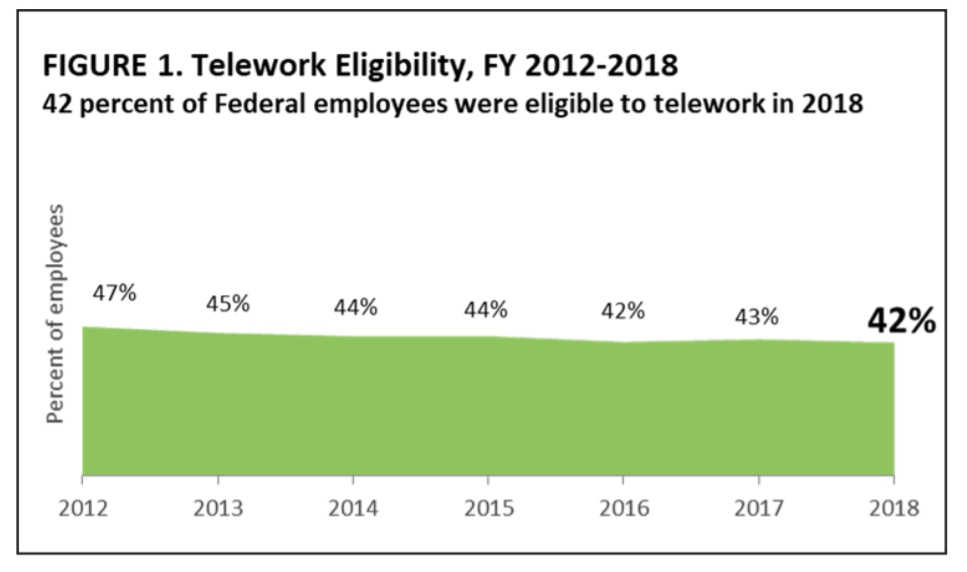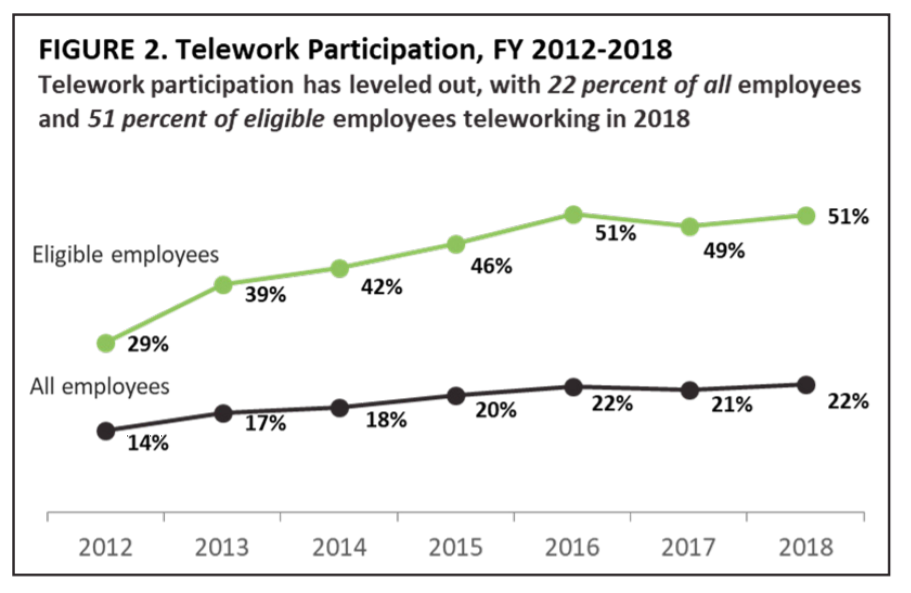
Latest OPM telework data reveals leaps and bounds agencies had to make during pandemic
Eligibility in federal telework programs dipped slightly in 2018, while participation experienced a small bump. The latest data from the Office of Personnel...
Newly released data on governmentwide telework participation in 2018 reveals just how hard agencies had to work over the past several weeks to expand the program during the ongoing coronavirus pandemic.
About 22% of the federal workforce teleworked at some point during fiscal 2018, according to the latest data from the Office of Personnel Management.
The data, though more than a year old, sheds light on the massive task many agencies faced in shifting large swaths of their workforces to telework during the current pandemic.
The report is dated March 2020 but was quietly posted to OPM’s website Thursday morning. It reflects a reality before the coronavirus — and before many agencies, including the Social Security Administration and the Education and Interior Departments, had made cuts or other changes to their telework programs.
Telework eligibility in the federal workforce dipped slightly in 2018, according to OPM. About 42% of federal employees were eligible that year, down slightly from 43% in 2017.
“Many agencies have not reevaluated their telework eligibility criteria since their programs were established,” the report reads. “As a result, the relative stability of telework eligibility rates may represent a missed opportunity for agencies to fully leverage telework and achieve various organizational goals. Particularly, a telework-ready workforce can help ensure that essential federal functions continue during emergency situations.”

The overall percentage of participation in telework programs improved slightly, with 22% of the entire federal workforce teleworking in 2018. Of the eligible federal workforce, 51% of employees participated in telework at some point in 2018, a 2% increase over the previous year.
“These numbers mirror FY 2016 participation percentages, and suggest that telework participation has stabilized over time,” OPM said. “Situational telework remains the most common form of telework participation, with nearly half — 45%— of teleworkers engaging in situational telework to some degree over the course of the fiscal year.”
Read more Workforce news
Agencies reported a total of 468,528 teleworkers in fiscal 2018, compared with 469,810 teleworkers during the previous year. The decrease in the total of overall teleworkers is primarily due to attrition, OPM said.
Several agencies individually reported attrition among their employees, which ultimately led to decreases in telework participation in 2018.

Looking at the data through the eyes of today’s pandemic, however, illustrates a different picture. Though some agencies clearly had active telework programs, many did not.
And several organizations had relatively small numbers teleworking, a signal of the difficulty agencies may have faced in “maximizing” the program for the majority of its employees.
Just 93 employees at the CIA, for example, teleworked in 2018.
Of the Office of the Director of National Intelligence’s workforce of 1,900 employees, just one person applied and was qualified for the agency’s situational telework program. That person did, in fact, telework at some point during that year, according to ODNI’s data.
About 8% of the workforce at the Department of Veterans Affairs teleworked in 2018, according to the data.
Roughly 38% of the Defense Department workforce was eligible for telework in 2018. Just 40% of DoD’s eligible workforce teleworked that year; 15% of overall DoD employees worked remotely in 2018.
Today, military services and other Defense components have achieved a five-to-tenfold increase in the number of users that can connect to their IT networks remotely.
OPM’s report shows most large agencies had relatively small proportions of their workforces teleworking in 2018, reflecting a potentially daunting reality for those organizations who have been forced to move their employees to telework to maintain or even expand critical public services during the pandemic.
At the Small Business Administration, for example, nearly half of employees were eligible to telework in 2018. But just 51% of those eligible employees participated in the agency’s telework program at some point in 2018. Just 24% of the SBA workforce teleworked at all that year.
Read more Technology news
The Social Security Administration, where telework was reduced earlier this year but reinstated on a nearly full-time basis during the pandemic, had 45% of its employees eligible for the program.
The vast majority of employees were eligible for telework at the Commerce Department, yet only 44% of them used the program in 2018.
About half of IRS employees were eligible for telework in 2018, about 45% of the agency teleworked at some point in the year.
Not all agencies provided complete information, and agencies continue to struggle with tracking and reporting participation and eligibility data. Some agencies rely on their employees to self-report when they worked remotely, others automatically track participation through time and attendance or other systems.
But telework continues to score well among federal employees, according to OPM data. Teleworkers, about 72%, are more engaged than non-teleworkers, 63%. They’re also more likely to stay at their agencies, 68% for teleworkers compared to 61% for non-teleworkers.
Copyright © 2025 Federal News Network. All rights reserved. This website is not intended for users located within the European Economic Area.
Nicole Ogrysko is a reporter for Federal News Network focusing on the federal workforce and federal pay and benefits.
Follow @nogryskoWFED





